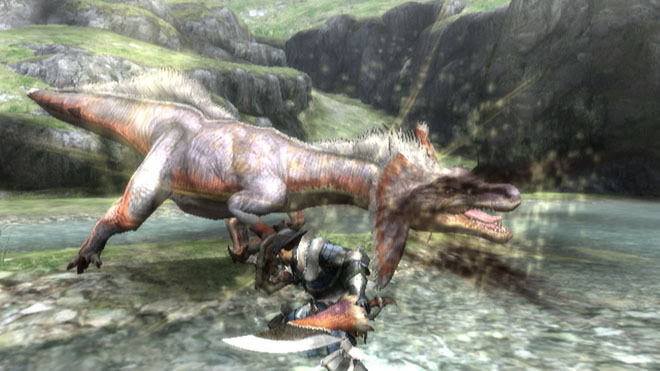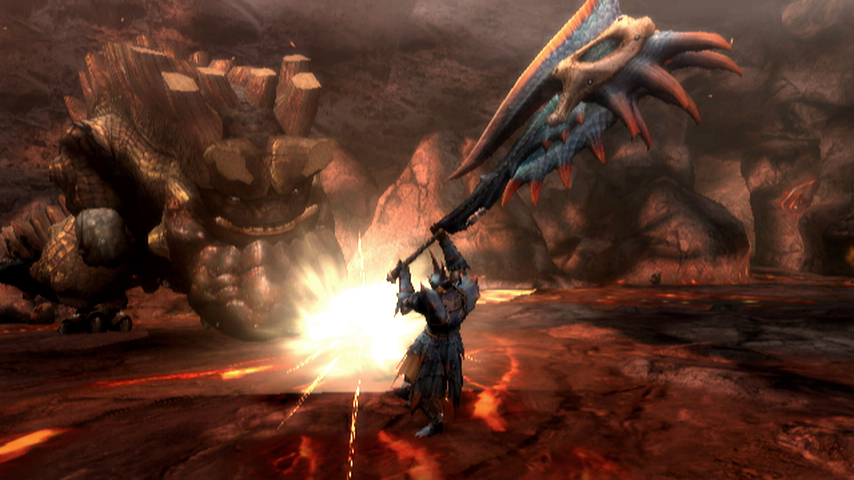Monster Hunter Tri, the latest installment in Capcom’s insanely popular franchise, reminds me very much of Phantasy Star Online, the Sega Dreamcast title that was one of the earliest examples of a game that let players go online and quest with other people — something that was futuristic to me in those days. The same hardcore gameplay and grind-heavy quest structure of PSO is very much present in Tri, except Capcom’s game depends on actual, well, monster hunting to gain new weapons and armor.
While PSO was popular enough here in the U.S. to see multiple expansions and sequels, Monster Hunter never enjoyed the same treatment. The Japanese are crazy about the series (I hear that if you don’t own the game, the government issues you a copy and a PSP), and Capcom is hoping to replicate that with this entry.
I have to say, Monster Hunter Tri is the game to do it.

Monster Hunter Tri casts you as a rookie monster hunter who has just arrived in the ocean town of Moga Village. Upon your arrival, a giant sea creature called the Lagiacrus apparently causes an earthquake that destroys much of the village’s resources, and the Village Elder recruits you to hunt down the Lagiacrus and in the process, restore some of the town’s buildings and resources. At this point, the story pretty much stops and the game becomes your playground to hunt monsters. Little bits of story progressions pop up, and special quests deemed “Urgent” progress the game along, but there isn’t a whole lot of narrative here. That’s not necessarily a bad thing, as the absence of a plot keeps you focused on what you want to focus on, instead of having to worry about remembering who is who or that there is impending doom in the game’s world.
The main single-player gameplay consists of freeform resource-gathering quests and quests assigned by The Guild. The freeform quests require you to gather resources in the starting area, Moga Woods, where they can be converted to Resource Points. The villagers will then issue requests for you to collect certain items or gain a specific amount of RP. As you fulfill these requests, you restore a bit more of the village and open up new services that will help you along, such as gaining fields to grow items or a Shroom Box that you can use to grow mushrooms. These quests are optional, but will help in the long run when you need a hard-to-find item and it’s easier to grow it than to go out and find it among hostile creatures.
The Guild quests are where the meat of both the single-player and multiplayer modes comes in. These quests task you with killing certain monsters or taking on bigger and harder boss monsters, and range from very easy to so hard you want to throw your controller at anything you see. This leads to one of my main issues wit the game. The boss monsters are these super strong, super resilient beasts that will take careful planning and the right loadout to drop them effectively. The problem, though, is that they are still extremely difficult to take down alone, even with the proper preparation. It feels like these monsters were built for teams of four to take down, as in multiplayer, and they turn into battles of attrition. I took on a quest to down a boss monster, and I actually ran out of quest time to do it. I fought it for 50 long minutes, and even then, there were no signs of it weakening. I brought all the right materials and weapons to the fight, but it was just too strong. If I’m attempting a series of single-player quests, they should be single-player focused, not multiplayer quests transported over.
Combat, obviously a big part of Monster Hunter Tri, is a mixed bag. At times, it’s got some of the most satisfying movements and strikes that you can execute, and you feel like a total badass when you link together a combo to knock back a beast. But at other times, it turns into a sluggish mess. You can’t change your attack’s direction, and depending on your weapon, you may find yourself moving at a stone’s crawl. Again, it feels like a class system where you need to have other players wielding other weapons to cover your bases.

Through all of this, the game keeps you hooked just like other great hack-and-slash RPGs. Like Diablo, the constant drive to get better armor and weapons keeps you hunting to gain the materials needed to craft them. Combining found items makes new and better ones, and the monsters actually follow rules of ecology to make hunting them all the more satisfying. Certain creatures only come out at night, they have different feeding and hunting habits, and they even have distinct calls that alert you to their intentions. It makes you feel like you are actually hunting something and once you bag your prey, you reap the rewards. It was an incredibly amazing experience when I set up a trap, lured my game towards the area, and then sprung my plan into motion to capture the monster.
The multiplayer is where the game really earns its stripes, though. Monster Hunter Tri features a full online mode, complete with servers, friends’ lists, and voice chat via the Wii Speak peripheral. The game logs onto Capcom’s own servers, so no overcomplicated friend codes here. Instead you use Capcom’s own ID system, which issues you a special code so players can identify you. They can also find you by your character’s name, instead of having to remember your ID number. In order to add people though, both players have to be online; you can’t just send a request to a player you know so they can answer the next time they are online. This is a bit of an annoyance, as it shouldn’t be that hard to implement the ability to send a request or message to an offline friend.
Online features most of the quests from single-player (again, transporting multiplayer quests to a single-player environment doesn’t work well), and also features a few unique ones that require teamwork to complete. These quests are divided into Hunter Ranks, or HR, and as you complete quests, your rank goes up, which allows you to take on higher HR quests. If you want to go solo you can, but like all other MMOs, there are a few that require you to team up to complete. The online community at the time of this review is very robust and extremely friendly. People were jumping at the chance to help me when I asked for it and always welcomed new players, offering tips and items.
Rounding out the features is the Arena Play mode, where players can take on the boss monsters in special arenas. This mode can be tackled offline, split-screen with a friend (you can take your hunter to a friend’s house via Wii Remote), or online with others. It’s both a good way to practice against boss monsters or play a game locally with a buddy.
Monster Hunter Tri pushes the Wii to the limit graphically. It’s probably the best looking game since Super Mario Galaxy and the all the environments, monsters, and characters look stunning. Capcom implemented some impressive draw distances and added amazing effects that really add to the atmosphere. The Flooded Forest, a personal favorite region of mine, looks gorgeous. Water flows in from above through trees and down rock faces, and the underwater areas (a new feature to Tri) have a wonderful look to them. It’s a beautiful and stylistic game that really showcases the different effects that the Wii is capable of.
A lot of Wii fans cry out for “core” experiences and Capcom has really delivered with Monster Hunter Tri. Tri brings a deep, complex (albeit difficult), single-player game and combines it with a full-featured online component that will keep players engaged for a long time. If you’ve been looking for a different experience than minigame collections or light-gun shooters on the Wii, this is that game.

















